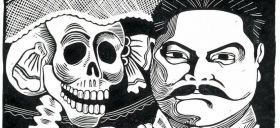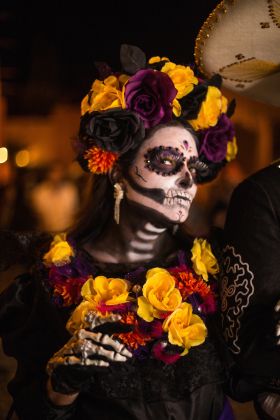What are the holidays of San Miguel de Allende?
Gretel Chazaro - Rancho Los Labradores
 The holidays in San Miguel de Allende are every weekend! There is always something to celebrate every weekend here like the Day of the Virgin, Day of San Miguel, and all the saints as well. Every little town around San Miguel also has their own festivities. They have huge parties to celebrate their town’s patron saint.
The holidays in San Miguel de Allende are every weekend! There is always something to celebrate every weekend here like the Day of the Virgin, Day of San Miguel, and all the saints as well. Every little town around San Miguel also has their own festivities. They have huge parties to celebrate their town’s patron saint. There is a very big festivity in San Miguel de Allende called Dia de los Locos (Day of the Crazies), which is a carnival much like...
 The holidays in San Miguel de Allende are every weekend! There is always something to celebrate every weekend here like the Day of the Virgin, Day of San Miguel, and all the saints as well. Every little town around San Miguel also has their own festivities. They have huge parties to celebrate their town’s patron saint.
The holidays in San Miguel de Allende are every weekend! There is always something to celebrate every weekend here like the Day of the Virgin, Day of San Miguel, and all the saints as well. Every little town around San Miguel also has their own festivities. They have huge parties to celebrate their town’s patron saint. There is a very big festivity in San Miguel de Allende called Dia de los Locos (Day of the Crazies), which is a carnival much like the ones in Brazil. It is celebrated in June. People from several groups in San Miguel come and join the street dance procession.
Dia de los Muertos (Day of the Dead) is also big in San Miguel, which includes the catrinas parade. My father, Sergio Chazaro started this observance here with only eight women that dressed up as catrina and went around San Miguel with my father giving out candies to the kids.
Halloween and Dia de los Muertos are very close together and Halloween was taking over Dia de los Muertos in Mexico. So instead of celebrating Dia de los Muertos, kids started celebrating Halloween more and they go around wearing costumes such as pirates, ghouls, and other Halloween characters. My father’s idea was to reintroduce to the people the character of catrina, which is the soul of a woman dressed in really fancy clothing who would walk you through the afterlife. The catrina was created in the 1900s by a man named Jose Guadalupe Posada, a political cartoonist, together with Diego Rivera, who is a famous painter and muralist. Posada created the character but it was Rivera who painted the character of a skeleton dressed in a very fancy dress much like what the upper class Spaniards would wear. After the Spanish invaded Mexico, they started having children with Mexicans. Even though their children were not pure Spanish, they had the ego of Spaniards being that one of their parents was Spanish. They were very arrogant. They didn’t like Mexicans and Mexicans didn’t like them. Posada made the character of catrina to make fun of these rich Spanish people and to point out that even rich people end up the same way as poor people after death. Everyone will be a skeleton one day, regardless of your status in life.
Presently, there are about 400 people who join the parade of catrinas on Dia de los Muertos. They all dress up as catrinas or catrines (for men). They all put make-up to look like skeletons wearing fancy dresses walking around the streets of San Miguel. They join the parades and give out candies to the kids. The parade is done on the evening of November 1st and Dia de los Muertos is every November 2nd. It such a big impact in San Miguel de Allende that many schools and organizations join the big parade.
The parade that we have in Rancho Los Labradores is now geared more towards tourism. You don’t have to be a member of a certain organization to join. It is a public parade. We get them the make-up, the hats, and the candies. We organize the parade of these 400 people and we hire a mariachi so if you come to San Miguel de Allende during this time, you will be able to participate in the parade instead of just watching it. Nowadays, kids do not dress up during Halloween any more; instead they dress up as catrinas during Dia de los Muertos.
(Artist Jose Guadalupe Posada with a catrina, a calavera of the female dandy, pictured.)
Posted August 10, 2016
Clementina Beas
 San Miguel de Allende is a hub for cultural activities throughout the year. There are the traditional Mexican holidays, and activities that take place during these holidays. For example, we have the Day of the Candelaria, when flowers and all kinds of plants are sold at the Parque Juarez. Dia De La Candelaria is a celebration of the beginning of the harvest in Mexico. All of the farmers and farmworkers celebrate the time of the harvest and the beginning of the planting season by...
San Miguel de Allende is a hub for cultural activities throughout the year. There are the traditional Mexican holidays, and activities that take place during these holidays. For example, we have the Day of the Candelaria, when flowers and all kinds of plants are sold at the Parque Juarez. Dia De La Candelaria is a celebration of the beginning of the harvest in Mexico. All of the farmers and farmworkers celebrate the time of the harvest and the beginning of the planting season by... San Miguel de Allende is a hub for cultural activities throughout the year. There are the traditional Mexican holidays, and activities that take place during these holidays. For example, we have the Day of the Candelaria, when flowers and all kinds of plants are sold at the Parque Juarez. Dia De La Candelaria is a celebration of the beginning of the harvest in Mexico. All of the farmers and farmworkers celebrate the time of the harvest and the beginning of the planting season by making offerings to the rain gods, and asking for a bountiful harvest.
San Miguel de Allende is a hub for cultural activities throughout the year. There are the traditional Mexican holidays, and activities that take place during these holidays. For example, we have the Day of the Candelaria, when flowers and all kinds of plants are sold at the Parque Juarez. Dia De La Candelaria is a celebration of the beginning of the harvest in Mexico. All of the farmers and farmworkers celebrate the time of the harvest and the beginning of the planting season by making offerings to the rain gods, and asking for a bountiful harvest. Another very celebrated holiday is Holy Week. On Good Friday during Holy Week, people go out onto the streets and walk around the different fountains in San Miguel de Allende, which are normally decorated with flowers, and wherein temporary altars have been built or created. The people who decorated the fountains normally greet people on the streets by offering them a popsicle or arroz con leche (rice with milk), or some type of drink.
There are always parties and festivities going on in San Miguel de Allende. In September, we celebrate the Mexican independence. El Jardin, the main plaza in San Miguel de Allende, holds a big celebration consisting of fireworks, mariachis and the pouring of tequila. This also includes live music in celebration of the freedom fighters who came through San Miguel de Allende and helped in liberating Mexico from Spain. During Independence Week, a lot of Mexicans and foreign tourists come into town just for this particular celebration.
On September 29th, we also celebrate the patron saint of San Miguel de Allende, during which time all of the adjacent neighborhoods in San Miguel de Allende have their particular celebrations and festivities that take place for a span of about a week or a week and a half. Each neighborhood and church often has a parade, and they come into the historical center of the town, playing live music with pre-Hispanic, Aztec, and Concheros dancers. These parades and celebrations are held in order to honor the patron saint San Miguel, or Saint Michael.
There’s one particular celebration called La Alborada, wherein fireworks are set off from El Jardin (the central area) before sunrise, and people go out to drink and to celebrate the patron saint of San Miguel de Allende. It’s a time when there are a lot of fireworks that are set off, including ‘castillos,’ a type of fireworks display where they light firecrackers attached to someone’s back, and that person then runs around town.
The Day of the Dead is celebrated between October 30th and November 2nd, during which time we celebrate the living and the dead. It is the day to honor the dead in Mexico, and Mexicans create altars in their homes and businesses in which they place photographs of their loved ones who have passed, along with marigolds, and food and drinks that their loved ones particularly liked. The idea is to invite their loved ones who have passed into the homes, to remember them with love, and to celebrate them as part of the living.
During the celebration, the living dress up as ‘Catrinas’ and ‘Catrines’, costumes that consist of dressing up in a black suit and tie for men, and painting their faces with a black and white skull. Women normally dress up in a tight black dress, with faces also painted, and wear a rather large colorful hat, which is often adorned with flowers. There’s elaborate face painting that goes into creating the skulls on their faces.
Here in San Miguel de Allende, we have several parades where men and women dress up as ‘Catrinas’ (female) and ‘Catrines’ (male) and walk from one point in town towards El Jardin. During these parades, people from all over San Miguel de Allende, tourists and residents alike, wait for the ‘Catrinas’ and ‘Catrines’ to arrive to take pictures, in celebration of the Day of the Dead.
People put up altars in public areas- El Jardin, around the public square, several fountains, and local restaurants and hotels to remember public figures, their loved ones, and anybody that they would like to commemorate. It’s a very beautiful sight for both tourists and residents to see, and many people come to El Jardin and walk around the central historical district, visiting all of the fountains, restaurants and hotels that have taken the effort to create these elaborate and often large altars that are very picturesque.
Both Mexican and foreign residents and tourists visit the cemetery between November 1st and 2nd. Mexicans who have loved ones buried in the cemetery normally go there a few days ahead of time and clear the gravesite and adorn it with flowers, food and drinks, as well as photos of their loved ones. On November first and second, Mexicans visit the gravesite along with their entire family. They also play music and enjoy the experience of celebrating the dead on that day. For foreigners who live here and are visiting, it’s an extraordinary experience to go to the cemetery on these days to see how the Mexicans celebrate their loved ones who have passed.
In addition, there are many different festivals as well as celebrations offered in town- stories about the Day of the Dead, movies, and all kinds of different celebrations and activities people can attend in order to learn more about the Day of the Dead, as well as to celebrate it.
(Day of the Dead celebration, San Miguel de Allende, Mexico, pictured.)
Posted November 29, 2016


